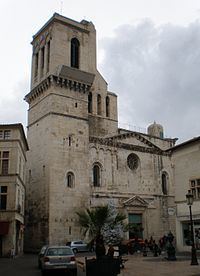Denomination Roman Catholic Patron saint Notre Dame Area 5,880 km² Metropolitan archbishop Pierre-Marie Carré | Country France | |
 | ||
Population- Total- Catholics (as of 2004)623,125364,523 (58.5%) Established Name Changed: 27 April 1877 Ecclesiastical province Roman Catholic Archdiocese of Montpellier | ||
The Roman Catholic Diocese of Nîmes (Latin: Dioecesis Nemausensis; French: Diocèse de Nîmes) is a diocese of the Latin Rite of the Roman Catholic church in France. The diocese comprises all of the department of Gard. It is suffragan of the Diocese of Avignon.
Contents
By the Concordat of 1801 its territory was united with the Diocese of Avignon. It was re-established as a separate diocese in 1821 and a Brief of 27 April 1877, grants to its bishops the right to add Alais (the modern Alès) and Uzès to their episcopal style, these two dioceses being now combined with that of Nîmes. Therefore, correctly it is the Diocese of Nîmes (–Uzès e Alès) (Latin: Dioecesis Nemausensis (–Uticensis et Alesiensis); French: Diocèse de Nîmes (–Uzès et Alès)).
History
Nîmes (Latin: Nemausus) was an important city in Roman antiquity. The Pont du Gard is not far away.
Late and rather contradictory traditions attribute the foundation of the Church of Nîmes either to Celidonius, the man "who was blind from his birth" of the Gospel, or to St. Honestus, the apostle of Navarre, said to have been sent to southern France by St. Peter, with St. Saturninus (Sernin), the apostle of Toulouse. The true apostle of Nîmes was St. Baudilus, whose martyrdom is placed by some at the end of the 3rd century, and by others at the end of the fourth. Many writers affirm that a certain St. Felix, martyred by the Vandals about 407, was Bishop of Nîmes, but Louis Duchesne questions this.
There was a see at Nîmes as early as 396, for in that year a synodical letter was sent by a Council of Nîmes to the bishops of Gaul.
Bishops
The first bishop whose date is positively known is Sedatus, present at the Council of Agde in 506.
Other noteworthy bishops are:
Urban II, coming to France to preach the crusade, consecrated the Cathedral of Nîmes in 1096 and presided over a council. Pope Alexander III visited Nîmes in 1162. Clement IV (1265–68), born at Saint Gilles, in this diocese, granted the monastery of that town numerous favors.
St. Louis, who embarked at Aigues-Mortes for his two crusades, surrounded Nîmes with walls. In 1305, Clement V passed through the city on his way to Lyon to be crowned. In consequence of disputes about the sale of grapes to the papal household, Innocent VI laid an interdict on Nîmes in 1358.
The diocese was greatly disturbed by the Wars of Religion: on 29 Sept., 1567, five years before the Massacre of St. Bartholomew, the Protestants of Nîmes carried out the massacre of Catholics known in French history as the Michelade. Louis XIII of France at Nîmes issued the decree of religious pacification known as the Peace of Nîmes.
From 1800
Pilgrimages and saints
The following Saints are especially venerated in the present Diocese of Nîmes: St. Castor, Bishop of Apt (4th to 5th century), a native of Nîmes; the priest St. Theodoritus, martyr, patron saint of the town of Uzès; the Athenian St. Giles (AEgidius, seventh cent.), living as a recluse near Uzès when he was accidentally wounded by King Childeric, later abbot of the monastery built by Childeric in reparation for this accident, venerated also in England; Blessed Peter of Luxemburg who made a sojourn in the diocese, at Villeneuve-lès-Avignon (1369–87); Ste. Artimidora, whose relic are in Aimargues church.
